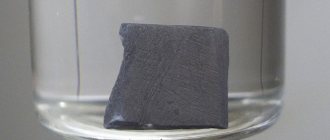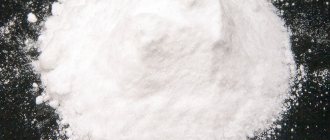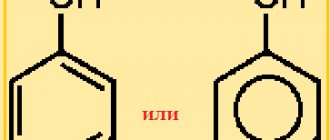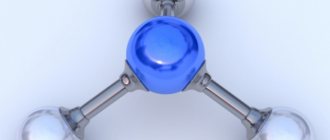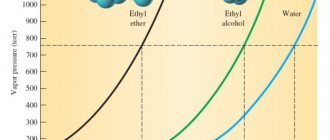Properties of sodium phosphate
Physical properties
| Property | Description |
| Appearance | White crystalline substance |
| Molar mass | 163.941 g/mol |
| Density | 2.536 g/cm3 |
| Melting temperature | 1340°C |
| Standard molar enthalpy of formation at 298K Δ G \Delta G ΔG °298, kJ/mol | -1922,8 |
| Standard molar Gibbs energy of formation at 298 K Δ\Delta Δ kJ/mol | -1819 |
| Standard molar entropy at 298 K S°298, J/(mol•K) | 224,7 |
| Solubility in water, 100 g | at 0°C - 5.4 at 25°C - 14.5 at 100°C - 94.6 |
Chemical properties
In aqueous solutions it hydrolyzes at the anion:
Na3P04 + H2O = Na2HP04 + Na0H.
The solution is alkaline.
When interacting with acids, it forms acid salts:
Na3P04 + HСl = Na2HP04 + NaCl,
Na3P04 + H2SO4 = NaH2P04 + Na2SO4.
Enters into exchange reactions to form insoluble phosphates:
2Na3P04 + 3CaCl2 = 6NaCl + 2Ca3(P04)2↓,
Na3P04 + AlCl3 = 3NaCl + AlP04↓,
Na3P04 + 3AgNO3 = 6NaCl + Ag3P04↓.
The latter reaction is a qualitative reaction to soluble alkali metal and ammonium phosphates. When a solution of silver nitrate AgNO3 is added to their solution, a yellow precipitate of silver phosphate Ag3P04 precipitates. And sodium can be detected by coloring the flame yellow.
How to identify an additive in a product?
Signs of an excessive dosage of sodium phosphates are a metallic or astringent taste and a “soapy” cut on the product (when cut, a feeling of stickiness and excessive moisture).
Based on its appearance, the presence of the food additive E339 in the product cannot be determined by eye. But the peculiarity of E339 is to protect food products from burning and preserve their natural color during heat treatment.
Can be determined by the inscription on the label. Possible names of food additives when labeling products can be:
- sodium salts of orthophosphoric acid;
- trisodium orthophosphate;
- monosubstituted sodium orthophosphate;
- disubstituted sodium orthophosphate;
- Monosodium Orthophosphate (II);
- Disodium Orthophosphate (iii);
- Trisodium Orthophosphate;
- Sodium Orthophosphates;
- sodium tripolyphosphate;
- Sodium phosphates;
- Sodium phosphates;
- Sodium phosphate;
- E 339, E-339, E339.
Preparation of a chemical compound
Laboratory methods of obtaining
Sodium phosphate is prepared by reacting phosphoric acid with sodium hydroxide or carbonate:
H3PO4 + 3NaOH = Na3PO4 + 3H2O; 2H3PO4 + 3Na2CO3 =2Na3PO4 + 3H2O + 3CO2↑.
Production of sodium phosphate in industry
In industry, sodium phosphate is produced in two stages.
First, by reacting soda ash Na2CO3 with phosphoric acid H3PO4, sodium hydrogen phosphate Na2HP04 is obtained:
Н3Р04 + Na2C03 = Na2HP04 + С02↑+ Н20,
and then by reacting sodium hydroxide NaOH with the resulting sodium hydrogen phosphate Na2HP04, sodium phosphate Na3PO4 is obtained:
Na2HP04 + Na0H = Na3P04 + H20.
After cooling the neutralized solutions to 30°C, sodium phosphate crystallizes in the form of Na3PO4·12H2O. It melts at 70°C. To obtain anhydrous sodium phosphate, the crystalline hydrate is calcined for 2 hours at a temperature of 120°C, and then for 30 minutes at a temperature of 800°C.
What can be replaced?
Food additive E339 can be replaced by :
- E452 - polyphosphates, food additive of the stabilizer category, are inhibitors;
- E450 - pyrophosphates, a food additive of the stabilizer category, excessive consumption threatens to deteriorate the absorption of calcium;
- E343 - magnesium orthophosphates, food additive of the antioxidant category, available both natural and synthesized;
- E340 - orthophosphates, food additive of the antioxidant category;
- E333 - calcium citrates, a food additive in the antioxidant category, are both natural and synthesized additives.
If there is no food additive E339 on the product label, it means that one of the substitutes listed above will be present.
Application
Sodium phosphate is used in everyday life as a cleaning agent, as it perfectly removes grease. Due to this property, it is also included in detergents. In addition, sodium phosphate softens water by converting hardness salts into insoluble phosphates:
3Ca(HCO3)2 + 2Na3P04 = 6NaHCO3 + Ca3(P04)2↓, 3Mg(HCO3)2 + 2Na3P04 = 6NaHCO3 + Mg3(P04)2↓. It is also used in the glass industry to produce optical glasses.
In construction, sodium phosphate is used to strengthen concrete. Its addition also increases the moisture resistance of concrete, as it becomes less porous.
In medicine, sodium phosphate is occasionally used as a laxative and heartburn remedy.
In the food industry it is known as food additive E339(iii). Sodium phosphate is used as an emulsifier, stabilizer, and moisture-retaining agent. It is added to mayonnaises and ketchups, processed cheeses and baked goods, although hydrogen phosphate (food additive E339(i)) and sodium dihydrogen phosphate (food additive E339(iii)) are more often used. Sodium phosphate is used to treat chicken legs, meat and fish to retain water and maintain weight.
It belongs to low-hazard substances (hazard class 4), but when overdosed in food products it leads to digestive disorders, and in children it often causes agitation and hyperactivity.
Effect on the body
No harmful effects on the body have been officially proven , nor has the opposite been proven. Therefore, scientists decided to consider the food additive as a low-hazard substance. Specific consumption standards that are safe for humans have also not been established.
Benefit
Benefits of dietary supplement E339:
- used as a laxative;
- added to dietary supplements and sports drinks.
Harm
Harm of food additive E339:
- interferes with calcium absorption;
- flushes water from the body, thereby harming the gastrointestinal tract;
- allergic reactions, severe rash, hyperactivity, aggressiveness are possible.
The dietary supplement is not recommended for use by children under 10 years of age.
Acceptable daily intake
By default, the daily norm is 70 g of supplements per 1 kg of human weight.
Excerpt describing Sodium Metaphosphate
“Spring, and love, and happiness!” - as if this oak tree was saying, - “and how can you not get tired of the same stupid and senseless deception. Everything is the same, and everything is a lie! There is no spring, no sun, no happiness. Look, there are the crushed dead spruce trees sitting, always the same, and there I am, spreading out my broken, skinned fingers, wherever they grew - from the back, from the sides; As we grew up, I still stand, and I don’t believe your hopes and deceptions.” Prince Andrei looked back at this oak tree several times while driving through the forest, as if he was expecting something from it. There were flowers and grass under the oak tree, but he still stood in the midst of them, frowning, motionless, ugly and stubborn. “Yes, he is right, this oak tree is a thousand times right,” thought Prince Andrei, let others, young people, again succumb to this deception, but we know life - our life is over! A whole new series of hopeless, but sadly pleasant thoughts in connection with this oak tree arose in the soul of Prince Andrei. During this journey, he seemed to think over his whole life again, and came to the same old reassuring and hopeless conclusion that he did not need to start anything, that he should live out his life without doing evil, without worrying and without wanting anything. On guardianship matters of the Ryazan estate, Prince Andrei had to see the district leader. The leader was Count Ilya Andreich Rostov, and Prince Andrei went to see him in mid-May. It was already a hot period of spring. The forest was already completely dressed, there was dust and it was so hot that driving past the water, I wanted to swim. Prince Andrei, gloomy and preoccupied with considerations about what and what he needed to ask the leader about matters, drove up the garden alley to the Rostovs’ Otradnensky house. To the right, from behind the trees, he heard a woman's cheerful cry, and saw a crowd of girls running towards his stroller. Ahead of the others, a black-haired, very thin, strangely thin, black-eyed girl in a yellow chintz dress, tied with a white handkerchief, from under which strands of combed hair were escaping, ran up to the carriage. The girl screamed something, but recognizing the stranger, without looking at him, she ran back laughing. Prince Andrei suddenly felt pain from something. The day was so good, the sun was so bright, everything around was so cheerful; and this thin and pretty girl did not know and did not want to know about his existence and was content and happy with some kind of separate, certainly stupid, but cheerful and happy life. “Why is she so happy? what is she thinking about! Not about the military regulations, not about the structure of the Ryazan quitrents. What is she thinking about? And what makes her happy?” Prince Andrei involuntarily asked himself with curiosity. Count Ilya Andreich in 1809 lived in Otradnoye still as before, that is, hosting almost the entire province, with hunts, theaters, dinners and musicians. He, like any new guest, was glad to see Prince Andrei, and almost forcibly left him to spend the night. Throughout the boring day, during which Prince Andrei was occupied by the senior hosts and the most honorable of the guests, with whom the old count's house was full on the occasion of the approaching name day, Bolkonsky, looking several times at Natasha, who was laughing and having fun among the other young half of the company, kept asking himself: “What is she thinking about? Why is she so happy!” In the evening, left alone in a new place, he could not fall asleep for a long time. He read, then put out the candle and lit it again. It was hot in the room with the shutters closed from the inside. He was annoyed with this stupid old man (as he called Rostov), who detained him, assuring him that the necessary papers in the city had not yet been delivered, and he was annoyed with himself for staying. Prince Andrei stood up and went to the window to open it. As soon as he opened the shutters, moonlight, as if he had been on guard at the window for a long time waiting for it, rushed into the room. He opened the window. The night was fresh and still bright. Just in front of the window there was a row of trimmed trees, black on one side and silvery lit on the other. Under the trees there was some kind of lush, wet, curly vegetation with silvery leaves and stems here and there. Further behind the black trees there was some kind of roof shining with dew, to the right a large curly tree, with a bright white trunk and branches, and above it was an almost full moon in a bright, almost starless spring sky. Prince Andrei leaned his elbows on the window and his eyes stopped at this sky. Prince Andrei's room was on the middle floor; They also lived in the rooms above it and did not sleep. He heard a woman talking from above. “Just one more time,” said a female voice from above, which Prince Andrei now recognized. - When will you sleep? - answered another voice. - I won’t, I can’t sleep, what should I do! Well, the last time... Two female voices sang some kind of musical phrase that constituted the end of something.
The product's name
The main name of the substance is sodium phosphates E 339 ( GOST R 52823-2007 ). The digital index (another spelling E–339) indicates the European code assigned to the food additive.
International synonym: Sodium phosphates.
There are names:
- food grade monosodium phosphates;
- sodium orthophosphates;
- sodium phosphate;
- Phosphate de sodium (French name);
- Mononatrium-phosphat, Natriumdihydrophosphat (German synonyms).
Literature
- Chemical Encyclopedia / Editorial Board: Zefirov N.S. and others. - M.: Great Russian Encyclopedia, 1998. - T. 5. - 783 p. — ISBN 5-85270-310-9.
- Chemist's Handbook / Editorial Board: Nikolsky B.P. and others. - 3rd ed., rev. - L.: Chemistry, 1971. - T. 2. - 1168 p.
- Lidin R.A.
and others. Chemical properties of inorganic substances: Textbook. manual for universities. — 3rd ed., rev. - M.: Chemistry, 2000. - 480 p. — ISBN 5-7245-1163-0.
| This is a draft article about inorganic matter. You can help the project by adding to it. |
Main manufacturers
Food grade sodium phosphates produce:
- Group (head office in St. Petersburg);
- Voskresensk phosphoric acid plant;
- Kazphosphate (Kazakhstan);
- CHEMICO GROUP (China).
Scientists around the world are demanding a ban on the use of phosphoric acid and its salts in washing powders: additives destroy cell membranes, change the composition of the blood, and provoke serious diseases.
But for some reason, no one raised the issue of banning sodium phosphates in food products, citing the fact that the substance is added in small quantities.
The consumer is forced to rely on the integrity of the manufacturers.

